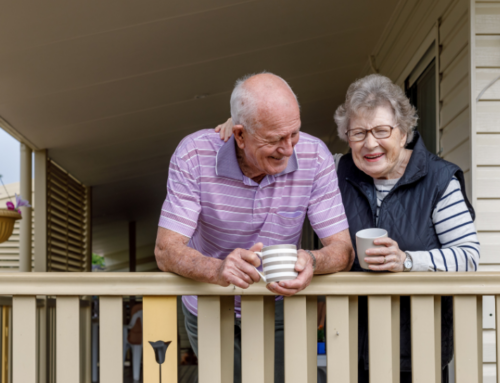Thriving Together: Uniting Volunteers, Families, and Seniors for Aging in Place
In the Book of Life, the chapter called Aging deserves and needs a little more care than our other chapters. Our needs change, and the community supports us. Becoming a senior is no different.
It takes a village to care for each other through life; when we age, the questions that arise can be unfamiliar. And when it comes to choosing to age in place, there are some essential questions to consider. Here are some:
- Will my home need to be modified to accommodate potential mobility challenges?
- How will I maintain my home and yard when daily physical activity becomes more challenging?
- What will I do to keep my sense of purpose and stay socially active to minimize loneliness and social isolation, even when my mobility and independence decline?
Whether you’re a senior, caring for an older adult, anticipating a time of caring for another, or looking to make a difference in the lives of seniors as a volunteer in your community, aging in place and understanding how it can benefit all is essential.
What is Aging-In-Place and Why is it Important?
“Aging in place” refers to seniors living in their homes and communities comfortably and independently as they age to preserve their autonomy, maintain social connections, and remain in a familiar environment, even as life’s circumstances evolve.
The positive effects of staying at home help loved ones avoid loneliness and depression when they leave their friends and families to live in an unfamiliar environment like a senior community.
For families caring for loved ones, aging in place can solve the difficulties that can arise when aging loved ones need a new kind of care and attention. For example, aging in place can make it easier to stay connected with family and friends, thus making it easier for families to visit nearby, and it can be less expensive than moving into a senior living community.
The importance of aging-in-place cannot be overstated; it offers advantages for seniors and their families.
For seniors, aging in place means more than just staying in the exact physical location. It means maintaining control over one’s life, which can profoundly impact emotional well-being and overall quality of life for them and their loved ones.
Some of the benefits of Aging-in-Place include
- Independence and autonomy: Seniors can maintain independence (not dependent on anyone) and autonomy (self-governance), make decisions, and live on their terms.
- Familiar Environment: The comfort of one’s home, filled with memories and personal touches, contributes to emotional well-being.
- Community Connection and decreased feelings of loneliness and isolation: Aging in place allows seniors to stay connected with neighbors, friends, and familiar surroundings, thus reducing loneliness and isolation.
- Cost-Effective: For some, aging in place can be more financially viable than assisted living or nursing homes.
- Physical Health: There is less risk of associated infections in senior living communities.
- Dignity and Respect: Aging in place can maintain a senior’s dignity by allowing them to age with grace in the surroundings they cherish.
In addition, from a community perspective, aging in place contributes to the strength and cohesion of neighborhoods. Seniors who remain active and engaged in their communities can foster intergenerational relationships and share valuable life experiences. This interaction creates a reciprocal exchange of wisdom and vitality, enriching the lives of everyone involved.
And while there are many benefits to aging in place, challenges must be considered. However, these challenges can be mitigated by community support and non-profit agencies geared toward the aging-in-place demographic.
Some of the challenges of Aging-In-Place include:
- Only 10% of American homes are “aging ready.” : This means homes may not have health and safety in place, such as step-free entryways and showers, a bedroom and bathroom on the first floor, and bathroom accessibility features. For some, modifying their homes is cost-prohibitive.
- Social isolation and loneliness: If community involvement isn’t introduced to seniors or their families, these two assaults on health and well-being can occur.
- The cost of staying at home: Staying at home can be prohibitive for some if help and care aren’t found in the community in a low-cost or voluntary way.
- Caregiver Strain: Family caregivers may experience physical and emotional strain while providing support.
- The risk of loneliness and isolation: While these can also be mitigated by staying at home, they can also be exacerbated if not considered with a plan to maintain connections.
Aging in place can be a solution for seniors, their families, people looking to serve and have a purpose, and the community.
Let’s look at how we can unite to create a fulfilling and empowering experience for seniors, caregivers, and volunteers alike so we all thrive together.
The Role of Volunteers, Why They’re Essential, and How Everyone Thrives
Volunteers are essential to the aging-in-place community, providing invaluable support beyond mere assistance.
Best stated by the National Council of Nonprofits, “Volunteers are a tremendous resource for charitable nonprofits. Many charitable nonprofits would not be able to conduct programs, raise funds, or serve clients absent volunteers.”
Their impact resonates emotionally, physically, and socially, benefiting seniors and themselves. The benefits of volunteering can be surprising, but helping others as a way of participating in communities and reaping benefits for ourselves is well-proven.
- A Source of Connection and Companionship: Volunteers offer seniors more than practical aid — they provide a lifeline of companionship. Regular visits, conversations, and shared activities provided by aging-in-place nonprofits foster genuine bonds that alleviate isolation and boost seniors’ emotional well-being.
- Mutual Health Benefits: Engaging with aging-in-place seniors also brings unintended rewards for volunteers. Physical activities such as light chores and gardening keep volunteers active, while mental engagement through conversations develops social skills and builds meaningful relationships for all involved.
- Fulfillment and Purpose: Volunteering creates a sense of purpose that enriches seniors’ lives and volunteers’ sense of accomplishment. Volunteering can help take your mind off your worries and build a sense of gratitude, which has been shown to reduce feelings of stress and anxiety.
- Cultivating Empathy: Engaging with seniors develops empathy and compassion in volunteers. Understanding seniors’ challenges nurtures these qualities, positively influencing other areas of volunteers’ lives and relationships. And there can never be too much empathy.
Volunteers weave threads of connection, compassion, and companionship in the tapestry of aging in place. Their role can extend beyond support and add to a thriving community where seniors and volunteers find enhanced happiness and well-being.
The Growing Need For Assistance By Adult Children
As people live longer, a new paradigm exists for understanding the family relationship and aging. There is a complex interplay between generations as adult children step into the role of caregiver with a delicate balance between respecting their parent’s independence and their growing need for assistance.
Along with this new paradigm is the other intricate situation of “the sandwich generation.” Adult children not only have to maneuver through a new situation with their aging parents, but they’re doing so while working full-time jobs and, often, still raising children. This intricacy produces the need for help for many adult children. From their parents’ health needs, safety at home considerations, and financial considerations to protecting their parents from loneliness and isolation and their own well-being.
The role of adult children caring for their senior parents is shifting. With the increased number of seniors aging over the following decades, the need for services will grow exponentially.
- Practical Assistance and Daily Tasks: The spectrum of support adult children provide encompasses practical assistance that facilitates their parents’ ability to age in place comfortably. This spectrum can involve everything from grocery shopping, meal preparation, household chores, and safety remodels to managing bills, transportation, and appointments. Most adult children in the “sandwich generation” don’t have the time or expertise to put these support structures in place, so they need to find support in the community.
- Emotional Connection and Well-being: Beyond the practical aspects of daily tasks, adult children offer invaluable emotional support to their aging parents. The choice to age in place can bring feelings of isolation to an older adult, prompting adult children to fulfill the needs for companionship and social engagement. Being the caregiver of such essential aspects of aging parents can be a heavy burden on time and emotions, no matter how much love is involved. The help from community support through non-profit organizations can supply regular visits, quality time spent with seniors, regular check-ins, and more that assist in a lifeline of emotional well-being for the senior and their adult child.
Available Community Resources For Seniors
In the pursuit of aging in place, community resources become paramount. Non-profit organizations dedicated to aging-in-place older adults and their families shine as pillars of compassion and practical assistance. These organizations understand that aging in place is about nurturing, belonging, and purpose.
Non-profit organizations offer services tailored to individual needs, from promoting home safety to providing companionship, in-home meal delivery, well-being checks, and more. They create intergenerational connections, infusing neighborhoods with camaraderie and shared purpose. Beyond services, ensure equitable access to support and empower families to navigate the complexities of aging.
In times of uncertainty, non-profits stand as steady allies, offering personalized care and compassion. Their commitment to empowering older adults, enriching lives, and fostering human connection creates a tapestry of support that unites volunteers, families, seniors, and communities in the meaningful aging-in-place journey.
A Final Thought
As people in our communities age and those we know and love enter the last chapters, we can’t ignore the care needed for their physical and emotional well-being can’t be ignored. Understanding aging-in-place, its benefits and challenges for older adults and their adult children, uniting volunteers, and supporting non-profits is how to move forward as a unified people.
Between the increasing number of the baby boomer generation over the next few decades due to longer lifespans, anything each of us can do to support them, their families, and the non-profits who provide services can make the chapters easier and kinder so all can thrive — the senior and their families, volunteers, and the community where they reside.
Click here to learn more about the aging-in-place resources ready to serve you and your loved one.
Sources:
- U.S. Surgeon General’s Advisory 2023, Our Epidemic of Loneliness and Isolation,
- DuPage Senior Citizens Council, Social Isolation and Loneliness Poses
- Health Risks—Part 1, 2023
- National Library of Medicine, Aging in Place, 08.2022
- National Council of Nonprofits, Volunteers
- HelpGuide.org, Volunteering and its Surprising Benefits
- The National Council for Mental Wellbeing. 11.17.2022, Mental Health FIRST AID
- The World Economic Forum, Ageing, and Longevity, 04.2022
- The Administration for Community Living, 2020 Profile of Older Americans, 05.2021
More Articles That Might Interest You
Aging-in-Place Non-profits: Your Business Supporting Workers Who Care for Loved Ones
Aging-in-Place Non-profits: Your Business Supporting Workers Who Care for Loved Ones Have you considered the impact of [...]
Meeting the Aging Wave: Why Supporting Aging-in-Place Organizations is Crucial for Employers
Meeting the Aging Wave: Why Supporting Aging-in-Place Organizations is Crucial for Employers In today's rapidly aging society, [...]
Celebrating Independence Day with Your Loved Ones: Ensuring Senior Safety and Well-Being
Celebrating Independence Day with Your Loved Ones: Ensuring Senior Safety and Well-Being As we prepare to celebrate [...]










